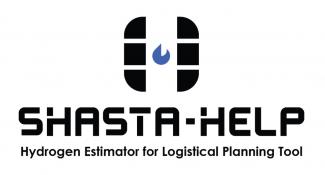A powerful new Hydrogen Estimator for Logistical Planning (HELP) tool has been released that can estimate the potential to store pure and blended natural gas-hydrogen mixtures in a range of subsurface formations — an important aid to help decarbonize the American economy and energy sector with clean hydrogen options.
The tool is a product of the Subsurface Hydrogen Assessment, Storage, and Technology Acceleration (SHASTA), a research collaboration between four U.S. Department of Energy (DOE) national laboratories: the National Energy Technology Laboratory (NETL), Pacific Northwest National Laboratory (PNNL), Sandia National Laboratories (SNL) and Lawrence Livermore National Laboratory (LLNL). The effort is supported by DOE’s Office of Fossil Energy and Carbon Management.
Hydrogen is emerging as a low-carbon fuel option for transportation, electricity generation, manufacturing applications, and clean energy technologies that will accelerate the United States’ transition to a low-carbon economy. However, a key challenge is to ensure the safe and effective underground storage of hydrogen.
Hydrogen is currently stored in salt caverns in locations around the world, but those geologic formations are not widely available throughout the United States. The SHASTA work seeks to address that problem by additionally exploring hydrogen storage in saline formations and depleted oil and gas wells that are more geographically disbursed throughout the U.S. Exploring storage opportunities in in porous media like underground natural gas storage reservoirs, is an important priority in expanding clean hydrogen storage options.
Large-scale hydrogen storage will be required as the nation transitions to a virtually carbon- and emissions-free clean energy economy.
SHASTA helps the planners in the hydrogen industry determine the viability, safety, and reliability of storing pure hydrogen or hydrogen-natural gas blends in subsurface environments like natural gas storage sites, depleted gas fields, saline aquifers, and salt caverns.
The latest online tool from the organization, SHASTA-HELP V.1.0.0 relies on a volumetric approach, accepts a variety of inputs, and is intended to be used for characterization or site screening purposes prior to detailed storage analysis that should be conducted by full reservoir simulation models.
The tool’s availability is the latest in the evolution of the underground hydrogen storage efforts of SHASTA. More improvements are on the horizon. Future versions of SHASTA-HELP will include functionality to:
- Rapidly assess hydrogen storage and delivery (including transient evolution and steady-state operations) in a variety of reservoirs.
- Perform techno-economic analyses for the construction of new subsurface hydrogen storage facilities or the conversion of existing facilities.
- Characterize storage potential amidst geologic uncertainty and assess the sensitivity of storage volumes to uncertain parameters.
- Facilitate the sharing of public or SHASTA-generated datasets.
- Interact with spatial (i.e., map-based) displays of tool outputs.
NETL brings a collection of technical research tools to the SHASTA effort including equipment that examines wellbore cement integrity, microbial characterization, sensors, testing and many other technical aspects of hydrogen storage.
The SHASTA initiative can accelerate and expand the use of hydrogen by using existing natural gas facilities at storage sites across the United States, by addressing critical technical hurdles, demonstrating the feasibility of emergent technology, and developing tools and technologies to support industry and by enabling the advancement of subsurface hydrogen storage.
NETL is a U.S. Department of Energy national laboratory that drives innovation and delivers technological solutions for an environmentally sustainable and prosperous energy future. By using its world-class talent and research facilities, NETL is ensuring affordable, abundant and reliable energy that drives a robust economy and national security, while developing technologies to manage carbon across the full life cycle, enabling environmental sustainability for all Americans.




